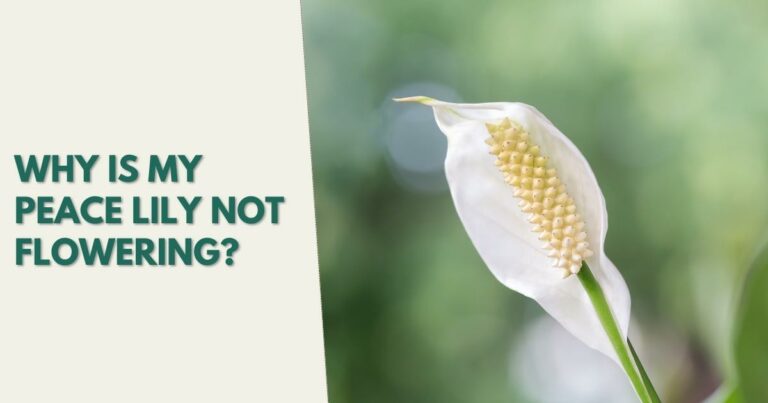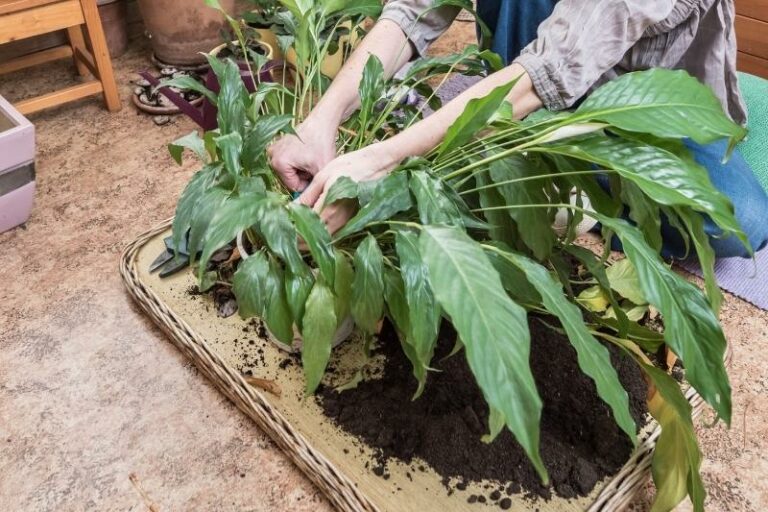The peace lily is a houseplant that is native to the tropical rainforests of Central and South America. It is a beautiful plant with large leaves.
According to NASA studies, peace lilies are great natural air purifiers thanks to their ability to remove harmful substances such as formaldehyde from the air.
Not only has the peace lily beautiful leaves, but its flowers are also a sight to behold. That is, of course, if you can get your peace lily to produce flowers at all. Is your peace lily not blooming? There may be several reasons for that. Let’s look at them now!
Why Is My Peace Lily Not Flowering Anymore?

The most common reason why a peace lily may not be producing flowers is the lack of lighting. The peace lily can withstand harsh conditions without much trouble. However, if the plant receives insufficient light, it will stop blooming. Other reasons may include improper watering, fertilizing, or low temperature.
Fortunately, all these problems should be relatively easy to fix. Let’s dive deeper into the problems and solutions.
Insufficient Lighting
Although a peace lily is a plant that grows in rainforests where there’s not much light, it does require a moderate amount of light when grown indoors. Direct sunlight is certainly not the best way to go.
Peace lilies are considered easy-to-care-for house plants. They will survive even when there’s a lack of light in the room they are placed in. The unfortunate side effect is that the plant will not have enough energy to bloom. It will instead use all the energy to stay alive and produce new leaves.
The lush green leaves of peace lilies are beautiful. However, most people grow peace lilies for the white flowers.
So how much light does a peace lily need? It’s recommended to place the plant near a west or east-facing window. It does not necessarily need to be placed on the window sill. Just somewhere close to the window.
South-facing windows may work fine as well, but only if there is no direct sunlight going through the windows. Direct sunlight may scorch the leaves of the plant.
Lack of Nutrients
It is a common misconception thinking that a peace lily can grow without fertilizers. Yes, it may grow to some degree, but it will lack the energy to start flowering.
Make sure to fertilize your peace lilies regularly. Do not overdo it though as too much fertilizer is just as bad as no fertilizer.
Both water-soluble and slow-release fertilizers work fine for peace lilies. Go for a fertilizer that has balanced contents. We had good results with fertilizing every six weeks.
Improper Watering
Watering peace lilies either too little or too much can be a cause of lack of flower production.
A peace lily plant doesn’t need a lot of water but should be watered regularly about twice a week to ensure that the plant gets enough water. It is best to use room-temperature water, which can be placed in a pot and left alone overnight. This will reduce the number of chemical agents present in tap water.
Peace lilies have a penchant for moist soil, so it is necessary to water them well. Do not overwater the plant though. The soil should be moist, not completely drenched. Make sure you are using well-draining potting soil for growing peace lilies.
When you overwater a peace lily, it may cause the leaves to turn yellow and droop and it will stop producing flowers. Overwatering can also cause the plant to become affected by root rot. Root rot means that the plant may stop growing properly and even die.
Don’t forget peace lilies are tropical plants that grow in rainforests where air humidity goes through the roof. Therefore, apart from regular watering, they also like to have their leaves misted every few days with cool water.
Temperature Problems
Peace lilies are tropical plants that require warm temperatures to grow. They grow best with a minimum temperature of 65 degrees Fahrenheit (about 18 degrees Celsius).
The plant can withstand slightly lower temperatures during the winter season, If you want to see some peace lily flowers, the temperature should be at least 70 degrees Fahrenheit (about 21 degrees Celsius) during the flowering season which is typically in Spring.
If the room temperature is below the stated minimum, it may as well be the reason why your peace lily is not blooming.
If the temperature is too high, flower production may cease as well. The maximum recommended temperature is about 85 degrees Fahrenheit (about 30 degrees Celsius).
In terms of temperature fluctuations, the peace lily is not as picky as some of the other houseplants, but too wild temperature changes may stilly negatively affect the plant.
Your Peace Lily May Need Repotting

Almost all house plants require regular repotting as they grow larger and the peace lily is no exception. If the pot is too small for the plant, it may stop growing and flowering.
How do you know the peace lily needs a new pot? The easiest way to recognize that is to look at the bottom of the pot. If the roots have already started growing through the drainage holes of the pot, you can be assured it’s time to re-pot the plant.
When choosing a new pot for your peace lily, make sure it’s of the appropriate size. In general, it’s recommended to choose a pot that’s no more than two inches bigger in diameter than the old pot.
Terracotta pots are a great choice for peace lilies as the porous material helps wick away some of the excess moisture from the soil when you water the plant.
Maybe It’s Not the Blooming Season Yet
Although there are exceptions, you should not be expecting your peace lily to bloom all year long. Peace lilies typically start blooming in early Spring and will stop blooming during Summer. If the conditions are right they may produce new flowers during Fall as well.
You can promote more blooming by deadheading your peace lilies. While it might sound scary to beginners, the process is dead simple. All you have to do is to cut or pinch off the wilted flower together with its stem.
Your Peace Lily May Be Too Old or Too Young
There’s only one reason why plants are producing flowers and that is to reproduce. As the plant grows older, its’s ability to reproduce may be diminished. It’s the same with us, humans, right?
The same goes the other way. If your plant is too young, it may be too early to expect it to bloom. But don’t worry, provide proper conditions for your peace lily and it will reward you with beautiful flowers in no time.
On the net, you will often find that the lifespan of peace lilies is only about 3-5 years. However, from our experience, the plant will last much longer than that.
Did you know? There are almost 50 known species in the genus of Spathiphyllum. The most common ones grown as houseplant are the species Spathiphyllum cochlearispathum and Spathiphyllum wallisii.
Frequently Asked Questions
Are peace lily flowers poisonous to cats?
Yes, every part of the peace lily plant including the flowers is poisonous to cats. According to the ASPCA, the plant contains oxalates, which may cause irritation of mucous membranes and skin. The symptoms of peace lily ingestion include swelling, drooling, vomiting, and others. Call your vet if you suspect your cat has eaten a part of your peace lily.
Do peace lily flower all year?
In some cases, peace lilies may flower all year long but it is more typical for them to flower heavily in Spring and less often in Fall.
Are peace lily flowers supposed to die?
Yes, peace lily flowers will last for about a month, rarely for two months, before dying back. You should deadhead the plant to promote new blooming.
What makes peace lily flowers turn green?
The spathe of peace lily may turn green when the plant receives too much light. It is a result of increased photosynthesis.
According to Dr. Leonard Perry of the University of Vermont, it may also be caused by using too much fertilizer.
Is that white leaf actually the flower of the peace lily?
No, the white leaf is the spathe. It is a modified leaf called the bract in botany. In the Araceae family of plants, the spathe looks like a petal and its purpose is to attract pollinators. The flowers of peace lilies are tiny and they are located on the inflorescence called spadix which is enclosed by the spathe.
Final Thoughts
The peace lily is a common houseplant that does not require a huge amount of work. It thrives when it is given proper amounts of light and water. Proper care will ensure that the peace lily will grow and bloom beautifully.
We hope the solutions to why your peace lily has stopped flowering were helpful. Give them a try and you will see the plant will start blooming again.